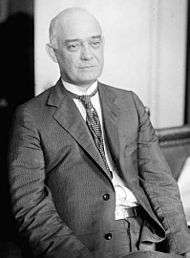Austin Peay
| Austin Peay | |
|---|---|
 | |
| 35th Governor of Tennessee | |
|
In office January 16, 1923 – October 2, 1927 | |
| Preceded by | Alfred A. Taylor |
| Succeeded by | Henry H. Horton |
| Personal details | |
| Born |
June 1, 1876 Christian County, Kentucky |
| Died |
October 2, 1927 (aged 51) Nashville, Tennessee |
| Resting place |
Greenwood Cemetery Clarksville, Tennessee[1] |
| Political party | Democratic |
| Spouse(s) | Sallie Hurst (m. 1895)[2] |
| Alma mater | Washington and Lee University |
| Profession | Attorney |
Austin Peay (June 1, 1876 – October 2, 1927) was an American politician who served as Governor of Tennessee from 1923 to 1927. He was the state's first governor since the Civil War to win three consecutive terms, and the first to die in office.[2] Prior to his election as governor, he served two terms in the Tennessee House of Representatives (1901–1905).
Widely considered one of Tennessee's most effective governors, Peay enacted numerous government reforms. He consolidated government agencies, overhauled the tax code, improved state schools, drastically expanded the state highway system, and converted the massive state debt into a budget surplus.[3] He also created Tennessee's first state park, and lent state support for the establishment of the Great Smoky Mountains National Park. During his tenure, the balance of power in state politics shifted from the state legislature to the governor.[2]
In 1925, Peay signed into law the Butler Act, which barred the teaching of the Theory of Evolution in public schools. The enactment of this law led to the Scopes Trial, which took place later that year.[3]
Early life
Peay was born in Christian County, Kentucky, the son of Austin Peay, a farmer, and Cornelia (Leavell) Peay. He attended Washington and Lee University in Lexington, Virginia, and Centre College in Danville, Kentucky, before moving to Clarksville, Tennessee, to practice law. He was practically penniless when he married Sallie Hurst in Clarksville in 1895.[4]
In 1900, Peay was elected to Montgomery County's seat in the Tennessee House of Representatives. During his first term, he introduced an anti-trust measure, which was quickly buried in committee.[4] His reputation among fellow Democrats improved during his second term, however, and he was elected chairman of the Tennessee Democratic Committee in 1905.[4]
In 1908, Peay managed Governor Malcolm R. Patterson's successful reelection campaign. In October of that year, Peay's campaign associate, Duncan Cooper, and his son, Robin Cooper, were involved a shootout in Nashville that killed Patterson's political foe, Edward W. Carmack. The Coopers had sought out Peay that morning to accompany them across town, and had they found him, he no doubt would have been present when the shootout took place.[4] Following this incident, Peay withdrew from state politics and returned to his law practice in Clarksville.[4]
Governor
In 1918, Peay returned to politics to seek the Democratic Party's nomination for governor, hoping to replace the incumbent, Tom Rye, who was not seeking reelection. His opponent, Albert H. Roberts, had the support of Nashville Banner publisher E.B. Stahlman and Memphis political boss E. H. Crump, and defeated Peay in the primary by 12,000 votes.[2]
In 1922, Peay again sought his party's nomination for governor. Crump and Stahlman supported aging former governor Benton McMillin for the nomination, though Peay had the support of Stahlman's rival, Nashville Tennessean editor Luke Lea, and Memphis grocery store magnate Clarence Saunders. Following a hard-fought campaign, Peay defeated McMillin for the nomination, 63,940 votes to 59,922.[2] Facing charismatic Republican incumbent Alfred A. Taylor in the general election, Peay canvassed the state, relying on forceful two-hour lectures at campaign stops, as opposed to Taylor's vaudeville-like stump appearances. On election day, he defeated Taylor 141,002 votes to 102,586.[2]
By the time Peay took office, Tennessee was struggling with a $3 million state debt and an outdated tax code that relied heavily on property taxes. The state had just 244 miles (393 km) of paved roads and few bridges, and its education system was ranked last in several categories. State government functions were scattered across sixty-four departments, many of which the governor had little control over.[3]
Following his inauguration in early 1923, Peay convinced the legislature to pass the Administrative Reorganization Act, which enabled him to make many of his later reforms. The measure consolidated the state's sixty-four departments into eight centralized departments: Finance and Taxation (now the Tennessee Department of Revenue), Agriculture, Highways and Public Works (now the Tennessee Department of Transportation), Education, Health, Institutions (now the Tennessee Department of Correction), Labor (now the Tennessee Department of Labor and Workforce Development), and Insurance and Banking (now the Tennessee Department of Financial Institutions).[2] Each new department was headed by a commissioner, who answered to the governor, and whom the governor had the power to hire and fire.[2] The measure also gave the governor control over the state budget.[3]
To update the state's antiquated tax code, Peay signed measures lowering property taxes while placing new taxes on corporate profits.[4] He gained a reputation as a budget watchdog, following a strict policy of paying for projects with available funding as opposed to bond issues.[4] By his third term, the state's $3 million debt had become a $1.2 million surplus.[3]
To expand the state's highway system, Peay installed professional engineer James G. Creveling as his Highways and Public Works commissioner. He implemented a 2% tax on gasoline and automobile registration fees to finance new road construction. By the time of Peay's death in 1927, Tennessee's highways had expanded from just 244 miles (393 km) to over 4,000 miles (6,400 km), including one highway connecting Memphis and Bristol at opposite ends of the state. Seventeen new bridges were also constructed.[3]
By the 1924 governor's race, Clarence Saunders, Peay's key supporter from 1922, was struggling financially, and was unable to help Peay's reelection effort. Peay obtained the support of Crump, however, by offering to locate the University of Tennessee's new medical school in Memphis. Stahlman refused to support the same candidate as his rival, Lea, however, and turned to fringe candidate John R. Neal. After easily defeating Neal in the primary, Peay defeated the Republican candidate, Thomas Peck, 152,000 votes to 121,238, in the general election.[2]
At the beginning of his second term, Peay turned to education reform by enacting the Education Act of 1925.[4] He expanded the school year to eight months (funded by a new tax on tobacco products), established licensing requirements and salary schedules for teachers, and increased funding for the University of Tennessee. During his tenure, the state's school system began shifting away from one-room rural schoolhouses to larger, more centralized schools.[2] The state also authorized the establishment of a normal school (modern Austin Peay State University) in Clarksville and an agricultural institute (modern University of Tennessee at Martin) in Martin.[3]
Peay dedicated Reelfoot Lake in Obion County (which had come under public control in 1914 following a lengthy and violent dispute) as a hunting and fishing reserve in 1925. This reserve was the basis for the modern Reelfoot Lake State Park.[4][5] Peay created the Tennessee State Parks and Forestry Commission that same year, and convinced the legislature to appropriate $1.5 million for the purchase of land in what would eventually become the Great Smoky Mountains National Park.[5]
In March 1925, Peay signed the Butler Act, banning the teaching of the Theory of Evolution in the state's schools. Peay stressed that he signed the law to protest the decline of religion in public schools, and did not believe it would be enforced.[6] This law was challenged that summer by Dayton teacher John T. Scopes and the American Civil Liberties Union in what became known as the Scopes Trial. This trial brought national media attention (and scrutiny) to the state.[6]
By the time the governor's race of 1926 began, Peay's reforms had angered numerous members of his own party. Crump, Nashville political boss Hilary Howse, and even his old benefactor, Saunders, had all turned against him, and had thrown their support behind Hill McAlister, who promised to undo Peay's reforms and decentralize the government.[2] Responding to the rising opposition, Peay simply stated, "Crump can't beat me."[4] Though he lost Shelby and Davidson counties, Peay picked up support in East Tennessee, and stunned Crump and his allies by defeating McAlister by 7,000 votes for the party's nomination.[2] In the general election, he easily defeated Republican candidate Walter White.[2]
Shortly after the beginning of his third term, Peay began suffering from a heart ailment. He continued working, however, vetoing a bill that would have given state legislators bonuses. When the legislature overrode his veto, he sued the legislature as a private citizen to prevent the measure from being enacted.[4] His health continued to decline, and he died from a cerebral hemorrhage on the afternoon of October 2, 1927.[4] He was buried in Greenwood Cemetery in his hometown of Clarksville.[1] He is the only Governor of Tennessee ever to die in office.[7]
Legacy
For years after his death, Peay's administration was remembered primarily for the Scopes Trial.[4] In recent years, his reputation has improved. A 1981 poll of fifty-two Tennessee historians that ranked the state's governors on ability, accomplishments, and statesmanship, placed Austin Peay at number one, slightly ahead of the iconic Governor John Sevier.[8]
Entities named for Peay include Austin Peay State University, which he had authorized while governor, a bridge over the Cumberland River (since demolished) in Jackson County, and a highway in West Tennessee (a portion of Tennessee State Route 14).
Family
Peay married Sallie Hurst in 1895. They had two children. Peay's father, grandfather, son, grandson, and great-grandson, are all named "Austin Peay."[9]
Peay is purported to have fathered a child at the age of fourteen with a twenty-eight-year-old African-American housemaid.[10][11]
See also
References
- 1 2 Austin Peay at Find a Grave
- 1 2 3 4 5 6 7 8 9 10 11 12 13 Phillip Langsdon, Tennessee: A Political History (Franklin, Tenn.: Hillsboro Press, 2000), pp. 303-309.
- 1 2 3 4 5 6 7 Dan Pierce, "Austin Peay," Tennessee Encyclopedia of History and Culture, 2009. Retrieved: 7 December 2012.
- 1 2 3 4 5 6 7 8 9 10 11 12 13 Joseph MacPherson, "Democratic Progressivism in Tennessee: The Administrations of Governor Austin Peay, 1923-1927," East Tennessee Historical Society Publications, Vol. 40 (1968), pp. 50-61.
- 1 2 Stuart Carroll, "Tennessee State Parks Celebrates Its 70th Anniversary," Tennessee Department of Environment and Conservation, 2007. Retrieved: 7 December 2012.
- 1 2 George Webb, "The Scopes Trial," Tennessee Encyclopedia of History and Culture, 2009. Retrieved: 7 December 2012.
- ↑ "Austin Peay," Tennessee History for Kids. Retrieved: 2 July 2013.
- ↑ Tennessee Historical Quarterly, Vol. 41, No. 1 (Spring 1982), p. 100.
- ↑ Montgomery County, Tennessee (Turner Publishing Company, 2000), p. 269.
- ↑ Chris Smith, "Famed Tennessee Governor May Have Had Black Child," Clarksville Leaf-Chronicle, 9/24/2013. Retrieved 9/25/2013.
- ↑ "PBS show claims Gov. Austin Peay was father of black housekeeper's child". Clarksville Now. Retrieved 4 April 2016.
External links
- Austin Peay – entry at the National Governors Association
- Governor Austin Peay Papers (finding aid) – Tennessee State Library and Archives
- Portrait painting of Governor Austin Peay – Tennessee Portrait Project
- Photographic portrait of Governor Austin Peay – Tennessee State Library and Archives
| Political offices | ||
|---|---|---|
| Preceded by Alfred A. Taylor |
Governor of Tennessee 1923-1927 |
Succeeded by Henry H. Horton |
